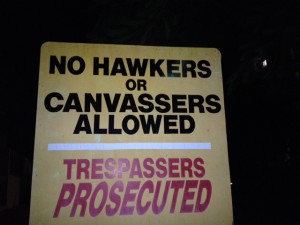Communication preferences tailored to supporter and organisation

 Is the person who lives here on your list? I walk by this home a couple of times per weekend because the house is on the same street as my Brisbane apartment.
Is the person who lives here on your list? I walk by this home a couple of times per weekend because the house is on the same street as my Brisbane apartment.
I chuckle each time I walk by the house. I am not making fun of the owner. It is within his or her right to post such a sign on their own property and on their letterbox. I simply wonder how many charities have this person on their database and I wonder if the person has ever alerted charities he/she wishes to be on a do not contact list, a do not solicit list, or some other alert.
When someone notifies you they do not wish to be contacted or wishes to opt out of certain communications, what action does your charity take? Do you mark the record “Do Not Contact”? Or, do you ask the supporter exactly what types of communications he or she does not wish to receive? Are you able to mark the supporter record to specify the exact types of communication rather than to code the record in your CRM to “Do Not Contact”, “Do Not Solicit”, “No Solicitations”, “No Mail”, “No Phone”, No Email”, “No SMS”? Would’t it be far better for you to be able use codes to document the supporter’s true communication preferences rather than blanket codes, which may prevent them to no receive communications they actually enjoyed? Codes such as:
- Tax Appeal
- Christmas Appeal
- The above examples allow your organisation to include all other supporters in all appeals and only include supporters marked “Tax Appeal” or “Christmas Appeal” if they have such a code in their record in the CRM.
- Newsletter – Electronic
- Newsletter – Post
- The above examples allow your organisation to include supporters with these codes when doing an email newsletter or when doing post newsletter, but to exclude them when doing one or the other if they have the opposite code in their record in the CRM.
- No solicitation – phone
- The above example allows your organisation to exclude anyone with this code from a telemarketing campaign when their is a solicitation involved. If the campaign involved a thank you call or some other purpose, your organisation might include the supporter in the calling program.
Communication preferences are vital. Organisations over-engineer and other organisations under-engineer the tracking of this critical data. Doing so means your organisation is short-chaning the donor and your organisation. Don’t cheat your supporter out of communications he or she may value. And, don’t cut the supporter off from communications, which will cause you to ultimately lose the support of the donor as a result.
